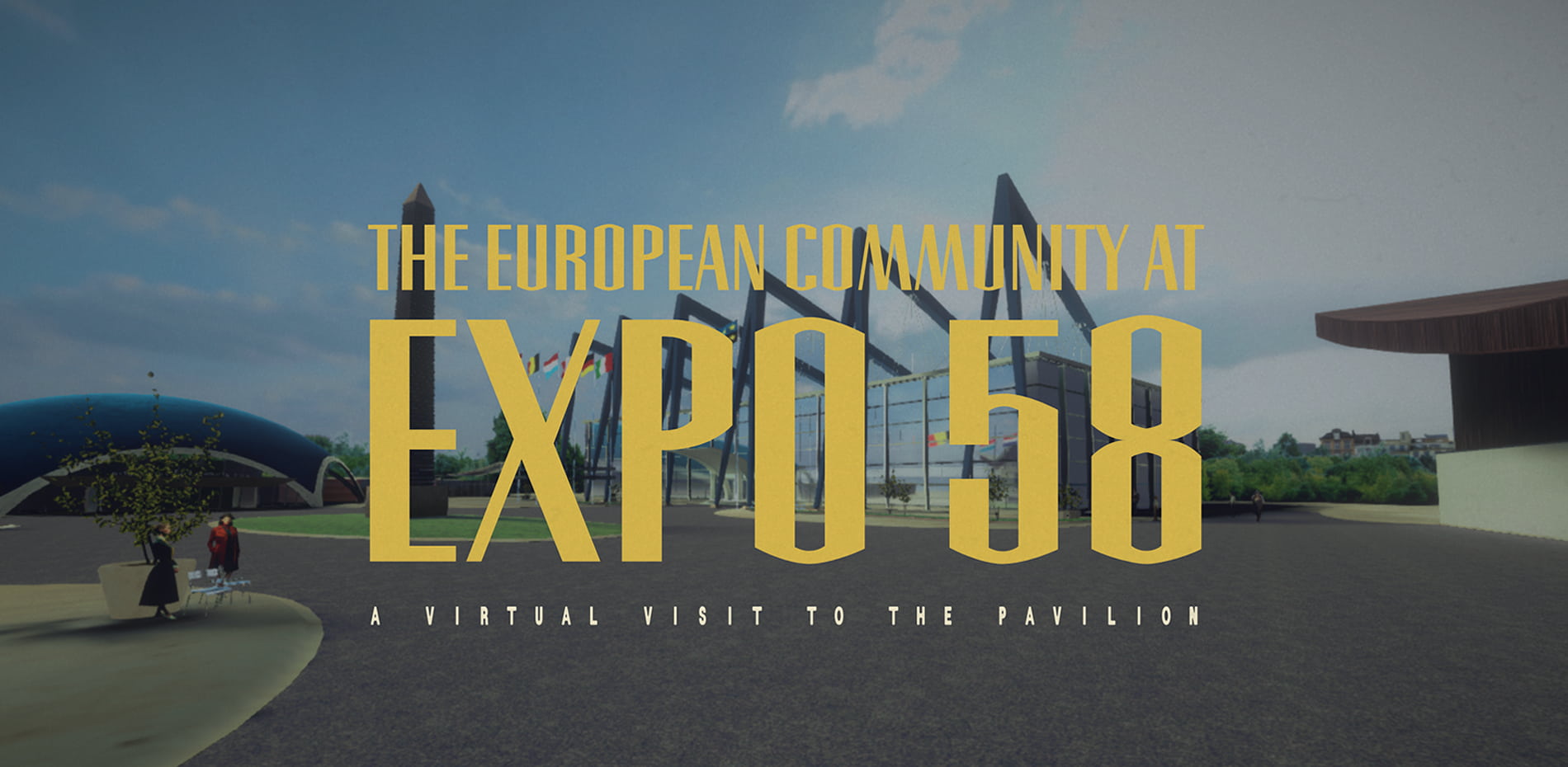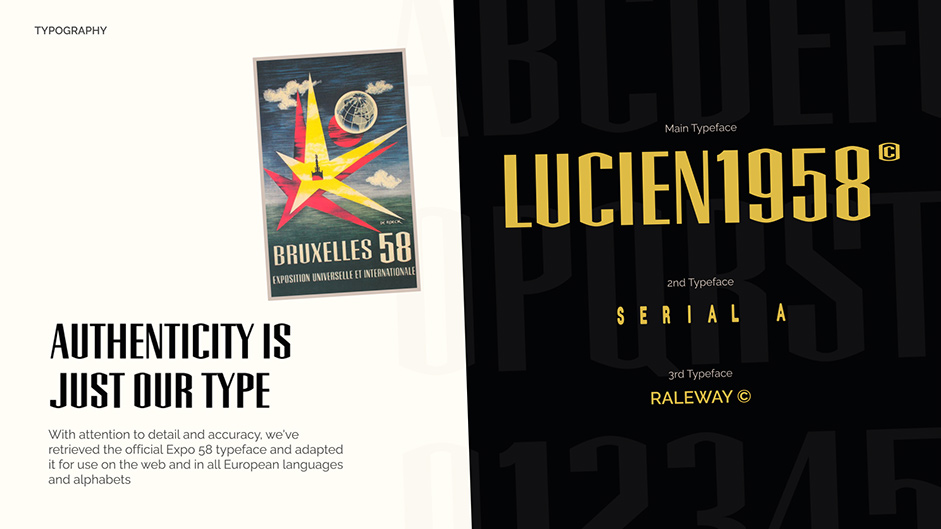
In 1958, the European Coal and Steel Community Pavilion at the Brussels Expo marked the beginning of a united Europe. Now, in 2023, the immersive experience that we developed at MONOGRID allows you to relive this historical moment on your device or through virtual reality.
European History, Reloaded for the Digital Age
The European Coal and Steel Community (ECSC) Pavilion at the 1958 Expo in Brussels did more than impress visitors with its bold architecture—it promoted a 'European consciousness' for the first time.
And to bring that pivotal moment in history to today's digital generation, the House of European History and Jean Monnet House museums, in partnership with the European University Institute (EUI), turned to us at MONOGRID.
So, 65 years after the Pavilion opened its doors and welcomed 6 million visitors, we've made it possible for countless more to relive this monumental event online from desktop and mobile devices or in VR at the Jean Monnet House in France.
From Black-and-White Archives to 3D Reality
Built to demonstrate the potential of steel, the ECSC Pavilion was an immense structure suspended by steel cables from six huge steel arches, representing the six Member States supporting the Community.
But all that remained of the iconic building were black-and-white archive photos. These images were often grainy and lacked the clarity and precision needed to create an accurate 3D model. With cultural historian and researcher Anastasia Remes' expert curation guiding us—based on her extensive work during her Ph.D. at EUI—we were granted access to a rich collection of visual and textual materials. These became our only architectural blueprint.
Our team extrapolated depth, texture, and context from the static, flat images available using advanced modeling techniques like texture mapping and photogrammetry. And from the multi-floor spaces to the depths of the underground coal mine, we ensured that every architectural feature faithfully resembled the original.
Humanizing History with AI-Generated Figures
To truly transport users to 1958, the Pavilion needed more than just walls and floors; it needed people.
The Speaking Avatars
First, we created two speaking avatars from 1958, enhancing navigation and providing helpful information and insights:
- a gracious hostess, sporting an authentic uniform from the time, to accompany visitors through the main halls
- a helmet-clad gentleman, guiding them through the coal mine
The AI-Generated Visitors
Yet, the Pavilion wouldn't be complete without its bustling atmosphere. That's why we populated it with AI-generated visitors, ensuring a diverse representation, reflecting various age groups and attires, avoiding repetitive patterns to maintain the authenticity of a live crowd and not break the immersion, and carefully reflecting the style and culture of the late 50s.
“With these dynamic elements combined, we didn't just recount history—we placed users right at the center of it.” – Francesco Bernabei, CEO of MONOGRID
Digital Toolbox: Crafting the Immersive Experience
To effectively produce an immersive and engaging model of the pavilion, we needed a powerful 3D authoring tool. This would ensure an accurate and flawless display of our design on the WebGL-powered website hosting the online experience.
Our thorough research led us to choose Unity, which served as the backbone for intricate 3D modeling and simulations. Thanks to its adaptability, we designed a custom add-on for our 3D design team to craft scenes, objects, lights, and animations that integrate seamlessly with a WebGL site.
This setup offered our designers a WYSIWYG (What You See Is What You Get) environment. Here, they could tweak light settings, camera angles, and movements, instantly viewing results independently, without consulting 3D developers. Moreover, our custom add-on also bridged communication and events between Unity's WebGL scenes and standard HTML5 elements, ensuring a fluid user experience where 3D interactions or animations could be easily triggered.
For the immersive VR offline experience, we integrated Oculus. The user interface, optimized for both accessibility and interactivity, was crafted using Vue3. The animation capabilities of gsap further complemented this. Web design details, for an engaging yet intuitive experience, were managed using CSS, and JavaScript ensured dynamic user interactions.
Crafting this rich, immersive experience demanded high-resolution assets and complex animations, but we couldn't compromise on performance. Especially with such a broad target audience, from desktops to VR, our goal was to achieve smooth performances across all platforms. On top of leveraging advanced compression techniques and meticulously optimizing our 3D models, Lottie allowed us to implement high-quality animations without overburdening the system.
Diving Deep with Virtual Reality
While the WebGL version offers users a taste of the 1958 ECSC Pavilion from their desktops and mobile devices, the offline Virtual Reality experience we crafted for the Jean Monnet House—optimized for Oculus—transports them directly into the heart of the event.
Using an Oculus headset, visitors are enveloped in a 360-degree panorama of the Pavilion's grandeur, experiencing a heightened sense of presence and spatial awareness that's impossible to capture on a flat screen.
Our team fine-tuned every detail to to harness the full potential of Oculus technology. From precise hand tracking to spatial audio integration. This not only allows users to interact with the environment more naturally but also hear the distant echoes of chatter, footsteps, and ambient sounds, accurately replicating the bustling atmosphere of the Pavilion in 1958.
Balancing Authenticity with User Experience
When you try to relive history, attention to detail is everything. Every nuance, from the vintage hairstyles to the era's clothing, was crucial to capture the essence of the time.
However, ensuring the digital environment felt like 1958 without compromising modern user experience paradigms was a tightrope walk. For instance, while reviving the Expo 58 original typeface, we had to adapt it for digital platforms without losing its historical essence. We couldn't just lift it directly from the archives, as it had to work seamlessly on today's web interfaces and ensure its legibility in all European alphabets (with plans to support 24 EU languages). This process required a careful blend of reverence for its history and an understanding of contemporary digital typography.
Striking this balance exemplified our commitment at MONOGRID: delivering a platform where history is cherished and experienced in a way that resonates with today's digital audience. With the ECSC Pavilion Immersive Experience we breathed life into a pivotal moment from Europe's past that everyone can relive now, become a part of the story.

Company Info
MONOGRID is a dynamic boutique agency delivering world-class multidisciplinary solutions always future-focused for the biggest international names in fashion and luxury, including Alexander McQueen, Dolce & Gabbana, Prada, and Vogue Italia, among others.
